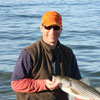How to Catch and Clean Fall Trout
By Tom Keer
Nov 02, 2016
Trout fishing in the fall may not offer action as hot as in the spring or summer, but it's one of the best times to be on the water. And when you catch one for the table, clean it quickly and easily.
Fall trout fishing is magical. As fish are moving into spawning mode or getting ready for their winter dormancy, they can be tough to catch. Crowds are thin and that makes catching brookies and rainbows as vibrant as the changing leaves special. But it's not easy fishing for trout, so here are four tips.
1. Think food. Most aquatic insect hatches are over for the year, but Blue-winged olive mayflies in small sizes are usually around. Beetles and hoppers are staples as are baitfish. Use beetles around low-hanging trees, hoppers in water adjacent to fields or meadows and baitfish in pools or runs.
2. Go dark. The normal aggressive feeding behavior is over, so replace brightly colored lures and flies with more muted patterns. Brown, gray, and black are top choices.
3. Surface or subsurface? Most anglers like surface fishing to catch trout because it's visual. But leaves falling on the surface makes it difficult to see your fly, and it's a pain to unhook a leaf after each cast. Fish on top on a calm day when there are fewer leaves and fish sub-surface on windy days.
4. Pick your area. Since the water temperatures are cool, trout move out of their summer lies. They'll move from fast pocket water and below feeder streams into deeper runs and pools. And for some pre-spawn action head to the tail of the pools where the trout are likely to congregate during their pre-spawn ritual.
Once you’ve caught a trout for the table, field dressing is the next step. You’ll only need a sharp pocket knife and about 20 seconds to clean your trout for the table.
1. Dispatch your trout with a sharp strike on the head.
2. Place your fish on its dorsal side and slide the point of your knife in the skin underneath the lower jaw. Your insertion point should be towards the back of the fish’s head.
3. With the blade parallel to the lower jaw and the sharp edge facing towards the kipe, cut the entire under-section away from the bottom jaw. Everything except for the lower jawbone should be attached to this one section.
4. With the fish still on its dorsal side, detach the top of the gills from the backbone. The top of the gills should be free from contact.
5. Grab the lower jaw and slowly pull back towards the tail.
6. The entire gills and entrails will accompany the cut away lower jaw.
7. Run the thumb of your nail along the backbone to remove the swim bladder and the kidney and you’re done. Rinse as necessary.
Now that dinner is ready, check our interactive map to plan your next fishing and boating fall adventure.
1. Think food. Most aquatic insect hatches are over for the year, but Blue-winged olive mayflies in small sizes are usually around. Beetles and hoppers are staples as are baitfish. Use beetles around low-hanging trees, hoppers in water adjacent to fields or meadows and baitfish in pools or runs.
2. Go dark. The normal aggressive feeding behavior is over, so replace brightly colored lures and flies with more muted patterns. Brown, gray, and black are top choices.
3. Surface or subsurface? Most anglers like surface fishing to catch trout because it's visual. But leaves falling on the surface makes it difficult to see your fly, and it's a pain to unhook a leaf after each cast. Fish on top on a calm day when there are fewer leaves and fish sub-surface on windy days.
4. Pick your area. Since the water temperatures are cool, trout move out of their summer lies. They'll move from fast pocket water and below feeder streams into deeper runs and pools. And for some pre-spawn action head to the tail of the pools where the trout are likely to congregate during their pre-spawn ritual.
Once you’ve caught a trout for the table, field dressing is the next step. You’ll only need a sharp pocket knife and about 20 seconds to clean your trout for the table.
1. Dispatch your trout with a sharp strike on the head.
2. Place your fish on its dorsal side and slide the point of your knife in the skin underneath the lower jaw. Your insertion point should be towards the back of the fish’s head.
3. With the blade parallel to the lower jaw and the sharp edge facing towards the kipe, cut the entire under-section away from the bottom jaw. Everything except for the lower jawbone should be attached to this one section.
4. With the fish still on its dorsal side, detach the top of the gills from the backbone. The top of the gills should be free from contact.
5. Grab the lower jaw and slowly pull back towards the tail.
6. The entire gills and entrails will accompany the cut away lower jaw.
7. Run the thumb of your nail along the backbone to remove the swim bladder and the kidney and you’re done. Rinse as necessary.
Now that dinner is ready, check our interactive map to plan your next fishing and boating fall adventure.
Popular Posts









